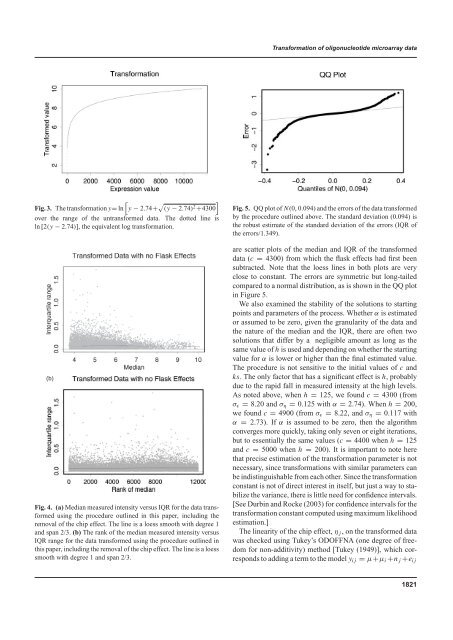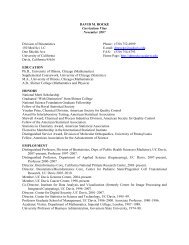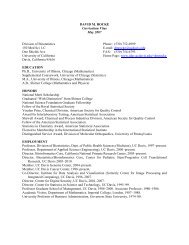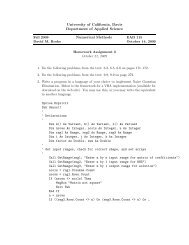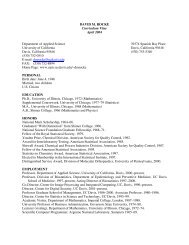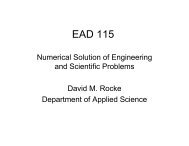S.C.Geller et al.only 8339 <strong>of</strong> the 12 625 genes (or <strong>of</strong> the 11 970 genes <strong>of</strong> the<strong>data</strong> subset) were usable as the other approximately 30% <strong>of</strong>the <strong>data</strong> had one or more <strong>of</strong> the replicates with non-positivevalues. Omission <strong>of</strong> such a large amount <strong>of</strong> <strong>data</strong> is not optimal.Even if it is considered that these <strong>data</strong> are unimportant in thissample, since the genes are not expressed at a high level, comparison<strong>of</strong> different conditions is made much more difficult ifa gene is expressed at a low level in one sample <strong>and</strong> a highlevel in another. Simply replacing negative estimated expressionvalues by some arbitrary positive value such as 10 or 20,or by an estimated mean, is also non-optimal since it distortsthe variability pattern <strong>of</strong> the <strong>data</strong>.4 TRANSFORMATION AND NORMALIZATIONThe approach we pursue is to formulate a model that fits thevariance patterns in the <strong>data</strong>, <strong>and</strong> that contains <strong>normalization</strong>constants, <strong>and</strong> then use a procedure that can simultaneouslydetermine the transformation parameter <strong>and</strong> the <strong>normalization</strong>.The statistical model used is that, for gene i <strong>and</strong> chip j,the measured (average difference) value y ij satisfiesf c (y ij ) = µ i + n j + ɛ ij ,where µ i is the true expression <strong>of</strong> gene i in the sample, n j is anadditive chip <strong>normalization</strong>, <strong>and</strong> ɛ ij is an additive symmetricmeasurement error.The back-transformed, normalized measurementsỹ ij = fc−1 [f c (y ij ) − n j ]+αare assumed to fit the two-component model, so thatV(ỹ ij ) = σ 2 ɛ + S2 η µ2 i .In this model, Sη 2 = eσ η 2 (eση2 − 1), which is to the first orderthe same as ση 2. For example, if σ η = 0.1, corresponding to a10% coefficient <strong>of</strong> variation, then S η = 0.1008.The transformation used is[ √]f c (y) = ln y − α + (y − α) 2 + c ,where c = σɛ 2/S2 η , or equivalently to the first order c =σɛ 2/σ η 2 . Note that we could treat α as negligible given that theprimary <strong>data</strong> are PM–MM, which can be presumed to have amean near zero for unexpressed genes, but actually estimatedall the values, including α. We will briefly examine the result<strong>of</strong> keeping α = 0. We can estimate σɛ2 from the low level<strong>data</strong> <strong>and</strong> ση 2 from the high level <strong>data</strong>, as in Rocke <strong>and</strong> Durbin(2001), but the values <strong>of</strong> σˆη , σˆɛ , <strong>and</strong> c are interdependent in thesense that we cannot determine σˆη <strong>and</strong> σˆɛ without knowing c,<strong>and</strong> vice versa. We solve this problem using the followingiteration:1. Starting with a trial value <strong>of</strong> c, transform the <strong>data</strong> using[ √]f c (y ij ) = ln y ij −ˆα + (y ij −ˆα) 2 + c .(We could use ˆα = 0 for these average difference <strong>data</strong>or estimate it.)2. Determine the <strong>normalization</strong> constants n j by taking themedian <strong>of</strong> all genes over each slide minus the median<strong>of</strong> all the genes on all the slides. Then, the transformed,normalized <strong>data</strong> aref c (y ij ) − n j .3. Back-transform the normalized transformed valuesusing the inverse transformationfc−1 (z) = ez − ce −z+ˆα.24. Determine the parameters σ ɛ <strong>and</strong> σ η <strong>of</strong> the twocomponentmodel by pooling low <strong>and</strong> high levels <strong>of</strong>expression as given in the Appendix <strong>and</strong> re-estimate α,a step not necessary when assuming that α = 0. We usea fixed number <strong>of</strong> genes at the high end, <strong>and</strong> at the lowend use all genes whose medians are sufficiently closeto α.5. Determine a new transformation parameter c = σɛ 2/σ η 2,<strong>and</strong> return to step 1 (using the original <strong>data</strong> not the backtransformed<strong>data</strong>).6. Stop the process when the parameter values stopchanging.For this application, we did not assume that the averagedifference scores <strong>of</strong> unexpressed genes average out to nearzero, so that α is estimated, rather than assumed to bezero. We check out the effects <strong>of</strong> assuming α = 0 below.We estimated σ η by pooling IQRs <strong>of</strong> the log transformed<strong>data</strong> corresponding to the highest h <strong>of</strong> the medians <strong>of</strong> the logtransformed <strong>data</strong> (see appendix). Also note that we cannotdetermine the transformation accurately without the iterative<strong>normalization</strong>. In our <strong>data</strong> the flask effects (flask medianminus overall median) on the transformed scale ranged from1/4 to 3/4 <strong>of</strong> a robust estimate <strong>of</strong> the st<strong>and</strong>ard deviation <strong>of</strong> theerrors, so would have affected our computation <strong>of</strong> c.The above procedure was applied to the autism <strong>data</strong>. Itconverged after 25 iterations to c = 4300 (from σ ɛ =8.20 <strong>and</strong> σ η = 0.125 with α = 2.74 <strong>and</strong> h = 125).Figure [ 3 is a graph <strong>of</strong> the transformation, f 4300 (y) =ln y − 2.74 + √ ](y − 2.74) 2 + 4300 , over the range <strong>of</strong> the<strong>data</strong> with a graph (dotted line) <strong>of</strong> z = ln [2(y − 2.74)], theequivalent log transform, for comparison. Figure 4a <strong>and</strong> b1820
<strong>Transformation</strong> <strong>of</strong> <strong>oligonucleotide</strong> <strong>microarray</strong> <strong>data</strong>[Fig. 3. The transformation y= ln y − 2.74+ √ ](y − 2.74) 2 +4300over the range <strong>of</strong> the untransformed <strong>data</strong>. The dotted line isln [2(y − 2.74)], the equivalent log transformation.(b)Fig. 4. (a) Median measured intensity versus IQR for the <strong>data</strong> transformedusing the procedure outlined in this paper, including theremoval <strong>of</strong> the chip effect. The line is a loess smooth with degree 1<strong>and</strong> span 2/3. (b) The rank <strong>of</strong> the median measured intensity versusIQR range for the <strong>data</strong> transformed using the procedure outlined inthis paper, including the removal <strong>of</strong> the chip effect. The line is a loesssmooth with degree 1 <strong>and</strong> span 2/3.Fig. 5. QQ plot <strong>of</strong> N(0, 0.094) <strong>and</strong> the errors <strong>of</strong> the <strong>data</strong> transformedby the procedure outlined above. The st<strong>and</strong>ard deviation (0.094) isthe robust estimate <strong>of</strong> the st<strong>and</strong>ard deviation <strong>of</strong> the errors (IQR <strong>of</strong>the errors/1.349).are scatter plots <strong>of</strong> the median <strong>and</strong> IQR <strong>of</strong> the transformed<strong>data</strong> (c = 4300) from which the flask effects had first beensubtracted. Note that the loess lines in both plots are veryclose to constant. The errors are symmetric but long-tailedcompared to a normal distribution, as is shown in the QQ plotin Figure 5.We also examined the stability <strong>of</strong> the solutions to startingpoints <strong>and</strong> parameters <strong>of</strong> the process. Whether α is estimatedor assumed to be zero, given the granularity <strong>of</strong> the <strong>data</strong> <strong>and</strong>the nature <strong>of</strong> the median <strong>and</strong> the IQR, there are <strong>of</strong>ten twosolutions that differ by a negligible amount as long as thesame value <strong>of</strong> h is used <strong>and</strong> depending on whether the startingvalue for α is lower or higher than the final estimated value.The procedure is not sensitive to the initial values <strong>of</strong> c <strong>and</strong>ks. The only factor that has a significant effect is h, probablydue to the rapid fall in measured intensity at the high levels.As noted above, when h = 125, we found c = 4300 (fromσ ɛ = 8.20 <strong>and</strong> σ η = 0.125 with α = 2.74). When h = 200,we found c = 4900 (from σ ɛ = 8.22, <strong>and</strong> σ η = 0.117 withα = 2.73). If α is assumed to be zero, then the algorithmconverges more quickly, taking only seven or eight iterations,but to essentially the same values (c = 4400 when h = 125<strong>and</strong> c = 5000 when h = 200). It is important to note herethat precise estimation <strong>of</strong> the transformation parameter is notnecessary, since transformations with similar parameters canbe indistinguishable from each other. Since the transformationconstant is not <strong>of</strong> direct interest in itself, but just a way to stabilizethe variance, there is little need for confidence intervals.[See Durbin <strong>and</strong> Rocke (2003) for confidence intervals for thetransformation constant computed using maximum likelihoodestimation.]The linearity <strong>of</strong> the chip effect, η j , on the transformed <strong>data</strong>was checked using Tukey’s ODOFFNA (one degree <strong>of</strong> freedomfor non-additivity) method [Tukey (1949)], which correspondsto adding a term to the model y ij = µ+µ i +n j +e ij1821


